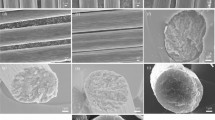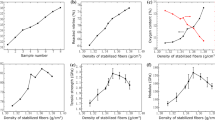Abstract
This study demonstrates that low processing rate for producing polyacrylonitrile (PAN)-based carbon fiber is a critical to obtain a homogeneous radial microstructure with high resistance to oxidation, thereby resulting in their improved mechanical strength. The dry-jet wet spun PAN organic fibers were processed (e.g., stabilized and then carbonized) utilizing two different rates; one is 1.6 times longer than the other. The effect of processing rate on the microstructural evolutions of carbon fibers was analyzed by scanning electron microscopy after slow etching in air, as well as Raman mapping after graphitization. The rapidly processed fiber exhibited the multilayered radial structure, which is caused by the radial direction stretching of the extrusion in the spinning. In case of the slowly processed fiber, the layered radial structure formed in the spinning process was changed into a more homogeneous radial microstructure. The slowly processed fibers showed higher oxidation resistance, higher mechanical properties, and higher crystallinity than the rapidly processed one. Raman mapping confirmed that the microstructure developed during spinning was sustained even though fiber was thermally treated up to 2800 °C.





Similar content being viewed by others
References
Gadiou R, Serverin S, Gibot P, Vix-Guterl C (2008) The synthesis of SiC and TiC protective coatings for carbon fibers by the reactive replica process. J Eur Ceram Soc 28(11):2265–2274
Gao P, Wang H, Jin Z (2004) Study of oxidation properties and decomposition kinetics of three-dimensional (3-D) braided carbon fiber. Thermochim Acta 414(1):59–63
Gupta A, Paliwal D, Bajaj P (1991) Acrylic precursors for carbon fibers. J Macromol Sci Part C Polym Rev 31(1):1–89
Serkov A, Budnitskii G, Radishevskii M, Medvedev V, Zlatoustova L (2003) Improving carbon fibre production technology. Fibre Chem 35(2):117–121
Perepelkin K (2003) Oxidized (cyclized) polyacrylonitrile fibres—oxypan. A review. Fibre Chem 35(6):409–416
Donnet JB, Bansal RC (1998) Carbon fibers. CRC Press, Boca Raton
Kelly V (2004) Carbon fiber: manufacture and applications. Elsevier, Amsterdam
Rahaman MSA, Ismail AF, Mustafa A (2007) A review of heat treatment on polyacrylonitrile fiber. Polym Degrad Stab 92(8):1421–1432
Ziabicki A, Kawai H (1985) High-speed fiber spinning: science and engineering aspects. Wiley, New York
Zielke U, Hüttinger K, Hoffman W (1996) Surface-oxidized carbon fibers: I. Surface structure and chemistry. Carbon 34(8):983–998
Jones L, Thrower P (1991) Influence of boron on carbon fiber microstructure, physical properties, and oxidation behavior. Carbon 29(2):251–269
Kercher AK, Nagle DC (2003) Microstructural evolution during charcoal carbonization by X-ray diffraction analysis. Carbon 41(1):15–27
Kim DH, Kim B-H, Yang KS, Bang YH, Kim SR, Im HK (2011) Analysis of the microstructure and oxidation behavior of some commercial carbon fibers. J Korean Chem Soc 55(5):819–823
Matsumoto T, Mochida I (1993) Oxygen distribution in oxidatively stabilized mesophase pitch fiber. Carbon 31(1):143–147
Blanco C, Lu S, Appleyard S, Rand B (2002) Micro-thermal analysis as a technique for in situ characterisation of the softening behaviour of the isotropic phase and mesophase in thermally treated pitches. Carbon 1(40):132–135
Roh J-S, Kim S-H (2009) Structural study of the oxidized high modulus carbon fiber using laser Raman spectroscopy. Carbon Lett 10(1):38–42
Wang S, Chen Z-H, Ma W-J, Ma Q-S (2006) Influence of heat treatment on physical–chemical properties of PAN-based carbon fiber. Ceram Int 32(3):291–295
Vázquez-Santos MB, Geissler E, László K, Rouzaud J-N, Martínez-Alonso A, Tascón JM (2011) Comparative XRD, Raman, and TEM study on graphitization of PBO-derived carbon fibers. J Phys Chem C 116(1):257–268
Lee Y-J, Radovic LR (2003) Oxidation inhibition effects of phosphorus and boron in different carbon fabrics. Carbon 41(10):1987–1997
Lee Y-J (2004) The second order Raman spectroscopy in carbon crystallinity. J Nucl Mater 325(2–3):174–179
Yoshida A (2006) Full width at half maximum intensity of G band in first order Raman spectrum of carbon material as a parameter for graphitization. TANSO 221:2–7
Cançado LG, Takai K, Enoki T, Endo M, Kim YA, Mizusaki H, Jorio A, Coelho LN, Magalhães-Paniago R, Pimenta MA (2006) General equation for the determination of the crystallite size La of nanographite by Raman spectroscopy. Appl Phys Lett 88(16):163106
Edie D (1998) The effect of processing on the structure and properties of carbon fibers. Carbon 36(4):345–362
Minus M, Kumar S (2005) The processing, properties, and structure of carbon fibers. Jom 57(2):52–58
Gupta A, Harrison I (1996) New aspects in the oxidative stabilization of PAN-based carbon fibers. Carbon 34(11):1427–1445
Gupta A, Harrison I (1997) New aspects in the oxidative stabilization of PAN-based carbon fibers: II. Carbon 35(6):809–818
Acknowledgements
This research was supported by the Hyosung Corporation, Basic Science Research Program, through the National Research Foundation of Korea (NRF) funded by the Ministry of Education (NRF-2018R1D1A1A02046116) and Nano Material Technology Development Program through the National Research Foundation of Korea (NRF) funded by Ministry of Science and ICT (NRF-2016M3A7B4905618). Y.A.K. acknowledged the financial support from the Technology Innovation Program (20000207) funded by the Ministry of Trade, Industry & Energy (MOTIE, Korea).
Author information
Authors and Affiliations
Corresponding authors
Additional information
Publisher's Note
Springer Nature remains neutral with regard to jurisdictional claims in published maps and institutional affiliations.
Electronic supplementary material
Below is the link to the electronic supplementary material.
Rights and permissions
About this article
Cite this article
Kim, DW., Kim, D.H., Kim, S.R. et al. Effect of low processing rate on homogeneous microstructural evolution of polyacrylonitrile-based carbon fibers. Carbon Lett. 29, 479–485 (2019). https://doi.org/10.1007/s42823-019-00047-7
Received:
Accepted:
Published:
Issue Date:
DOI: https://doi.org/10.1007/s42823-019-00047-7




